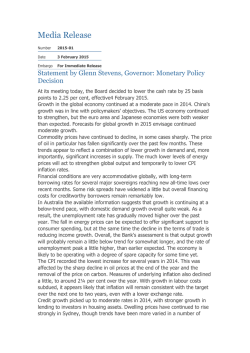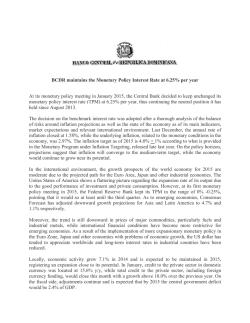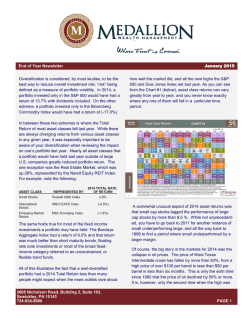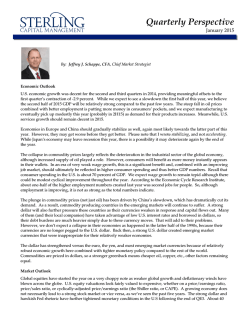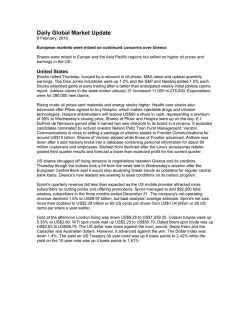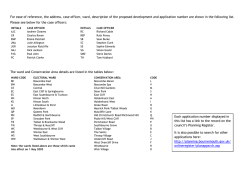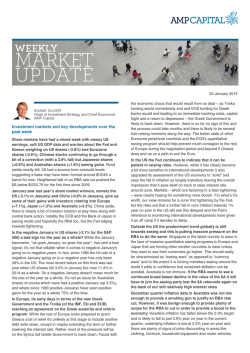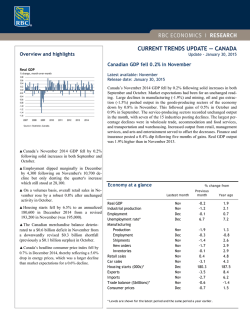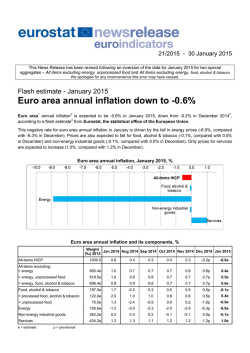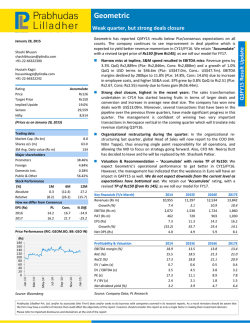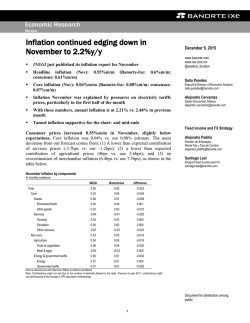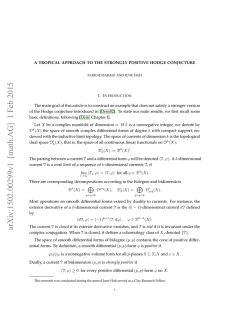
Download - Partners in Financial Planning
Partners in Financial Planning, LLC 421 S College Ave Salem, VA 24153 540-444-2930 Fax 540-266-3620 [email protected] www.partnersinfinancialplanning.com Market Month: January 2015 The Markets (Un)Happy New Year: Fresh uncertainties in Europe, slowing economic growth, anticipation of a looming Federal Reserve rate hike, and a stronger dollar all contributed to a volatile month for equities. The losses weren't good news for believers in the January Effect (the idea that equities' behavior in January suggests what might happen during the rest of the year). However, it might also be useful to remember that the S&P 500 lost 3.6% last January but ended 2014 up 11.4%. Oil prices fell below $50 a barrel, but that seemed to be a mixed blessing. Lower gas prices boosted consumers' spending power, but the sharp declines also raised questions about whether prices would fall so far that energy companies would cut back on jobs and/or ongoing operations. And as investors sought out the safety of U.S. Treasuries, the benchmark 10-year yield lost roughly half a percent in January as prices rose. Market/Index 2014 Close Prior Month As of 1/30 Month Change YTD Change DJIA 17823.07 17823.07 17164.95 -3.69% -3.69% Nasdaq 4736.05 4736.05 4635.24 -2.13% -2.13% S&P 500 2058.90 2058.90 1994.99 -3.10% -3.10% Russell 2000 1204.70 1204.70 1165.39 -3.26% -3.26% Global Dow 2501.66 2501.66 2441.41 -2.41% -2.41% Fed. Funds .25% .25% .25% 0 bps 0 bps 10-year Treasuries 2.17% 2.17% 1.68% -49 bps -49 bps Chart reflects price changes, not total return. Because it does not include dividends or splits, it should not be used to benchmark performance of specific investments. The Month in Review • The U.S. economy grew more slowly in Q4, according to the Bureau of Economic Analysis's initial estimate. The 2.6% increase in gross domestic product was roughly half the 5% seen in Q3. The BEA said increased imports, cuts in federal government spending, reduced business investment, and a downturn in exports helped slow economic growth. The major bright spot in the report was a 4.3% increase in consumer spending--the fastest growth since before the financial crisis. • The addition of 252,000 new jobs in December cut the unemployment rate by 0.2% to 5.6%. According to the Bureau of Labor Statistics, those additions exceeded 2014's 246,000 monthly average gain. Hourly wages fell 5 cents to $24.57, though they were 1.7% higher than in December 2013. • Europe got a lot of attention in January. The European Central Bank finally announced a long-awaited quantitative easing program worth at least €1.1 trillion ($1.3 trillion) to try to stimulate the sluggish economy there. Coupled with the Swiss National Bank's abandoning its cap on the value of the Swiss franc, the decision helped weaken an already struggling euro; at one point, the common eurozone currency was worth less against the U.S. dollar than it had been in 11 years. Page 1 of 2, see disclaimer on final page Key Dates/Data Releases 2/2: Personal income/spending, ISM manufacturing report, construction spending 2/3: Auto sales, factory orders 2/4: ISM services report 2/5: Business productivity, balance of trade 2/6: Unemployment/payrolls 2/10: JOLTS job turnover report 2/12: Retail sales, business inventories 2/17: Empire State manufacturing survey, international capital flow 2/18: Housing starts, wholesale inflation, industrial production, FOMC minutes 2/19: Philly Fed manufacturing survey 2/20: Options expiration 2/23: Home resales 2/24: Home prices 2/25: New home sales 2/26: Consumer inflation, durable goods orders 2/27: Q4 GDP (revised) • Greece elected a new president, Alexis Tsipras, whose anti-austerity party pledged to renegotiate the terms of bailouts that rescued the country from financial crisis in 2011 and 2013. The potential for confrontation with other European Union countries raised fresh questions about Greece's financial stability and continued EU membership. • The Federal Reserve's monetary policy committee once again said it is in no hurry to begin raising interest rates, in part because it foresees inflation slowing even further in the short term before eventually rising closer to its 2% target. The committee said it expects moderate growth to continue, and its statement expressed little concern about international economic weakness. • The largest monthly decline in U.S. consumer energy costs since December 2008 was largely responsible for December's 0.4% drop in the Consumer Price Index; the Bureau of Labor Statistics said consumer prices overall have increased only 0.8% over the last 12 months. Meanwhile, the plunging cost of oil also helped cut wholesale prices 0.3% for the month; the decline--the fourth in the last five months--was the sharpest drop in more than 3 years and left the 12-month wholesale inflation rate at 1.1%. • After a slow November, sales of new homes were up 11.6% in December, according to the Commerce Department. And existing-home sales bounced back in December; the National Association of Realtors® said sales rose 2.4% during the month. However, the S&P/Case-Shiller 20-City Composite Index suggested that home prices are showing signs of struggling; the index fell 0.2% in November, and the 4.3% increase over November 2013 was less than the 4.5% annual gain seen the previous month. • The Commerce Department said durable goods orders unexpectedly fell 3.4% in December--the fourth decline in the last five months. Though a 55% drop in commercial aircraft orders played a significant role in the weakness in new orders, the Commerce Department said business spending on capital equipment also fell 9.7%. Eye on the Month Ahead As the new Greek government settles in, investors will be assessing its chances of successfully altering the bailout agreement terms imposed by the so-called "troika"--the European Commission, the European Central Bank, and the International Monetary Fund. The current bailout agreement is scheduled to expire on February 28 unless an extension is granted. And with parts of the United States having been hit hard by two successive major winter storms, investors also may begin to wonder whether bad weather might chill the U.S. economy temporarily, as it did last winter. Data sources: Economic: Based on data from U.S. Bureau of Labor Statistics (unemployment, inflation); U.S. Department of Commerce (GDP, corporate profits, retail sales, housing); S&P/Case-Shiller 20-City Composite Index (home prices); Institute for Supply Management (manufacturing/services). Performance: Based on data reported in WSJ Market Data Center (indexes); U.S. Treasury (Treasury yields); U.S. Energy Information Administration/Bloomberg.com Market Data (oil spot price, WTI Cushing, OK); www.goldprice.org (spot gold/silver); Oanda/FX Street (currency exchange rates). News items are based on reports from multiple commonly available international news sources (i.e. wire services) and are independently verified when necessary with secondary sources such as government agencies, corporate press releases, or trade organizations. All information is based on sources deemed reliable, but no warranty or guarantee is made as to its accuracy or completeness. Neither the information nor any opinion expressed herein constitutes a solicitation for the purchase or sale of any securities, and should not be relied on as financial advice. Past performance is no guarantee of future results. All investing involves risk, including the potential loss of principal, and there can be no guarantee that any investing strategy will be successful. The Dow Jones Industrial Average (DJIA) is a price-weighted index composed of 30 widely traded blue-chip U.S. common stocks. The S&P 500 is a market-cap weighted index composed of the common stocks of 500 leading companies in leading industries of the U.S. economy. The NASDAQ Composite Index is a market-value weighted index of all common stocks listed on the NASDAQ stock exchange. The Russell 2000 is a market-cap weighted index composed of 2,000 U.S. small-cap common stocks. The Global Dow is an equally weighted index of 150 widely traded blue-chip common stocks worldwide. The U.S. Dollar Index is a geometrically weighted index of the value of the U.S. dollar relative to six foreign currencies. Market indices listed are unmanaged and are not available for direct investment. Partners in Financial Planning, LLC is a fee-only financial planning and investment management firm located in Salem, Virginia. Our mission is to provide comprehensive, caring financial guidance that allows our clients to spend less time worrying about their finances and more time enjoying their lives. The information provided herein is intended for general educational and informational purposes. Please consult with your financial advisor for tailored advice related to your specific situation. Page 2 of 2 Prepared by Broadridge Investor Communication Solutions, Inc. Copyright 2015
© Copyright 2025
